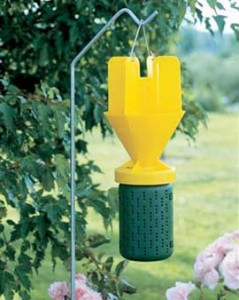A decade ago garden centers sold thousands of Japanese beetle traps until somebody questioned why anyone would want to lure this summer pest into their garden. Yes, the traps do work and may catch hundreds per week. You also attract hundreds more to feed on your plants’ flowers and leaves and, later in the year, the larvae will feed in the soil on lawn grass roots.
Most Japanese beetle traps contain two sex pheromones in a brightly colored container. Japanese beetles feed in groups and mate. Pheromone traps attract far more beetles than they actually capture. You’re inviting every Japanese beetle in the neighborhood into your yard, but only a small percentage end up in the traps. If you convince the entire neighborhood to hang up Japanese beetle traps, you may effectively stop their migration from yard to yard and effectively reduce their numbers.
Beetle adults feed on nearly 300 different host plants. Some of the more common targeted landscape plants include: roses (Rosa spp.), flowering cherry (Prunus spp.), flowering crabapple (Malus spp.), shrub althea (Hibiscus syriacus), hollyhock (Althaea rosea), linden (Tilia spp.), and grape vines (Vitis spp.). Adults feed all day on the flowers and/or leaves. Damaged leaf tissue takes on a lacey or skeletonized look as beetles feed between the leaf veins.
Japanese beetle traps are useful monitoring tools for determining whether the insect population numbers in your yard necessitates pesticide control. The following pesticides are used for reducing Japanese beetles:
- Carbaryl (Sevin®)
- Cyfluthrin (Bayer™ Advanced Pest Control)
- Neem Oil (organic pesticide)
- Acephate (Orthene®)
- Triazicide® (for soil application against larvae)


 Posted in
Posted in 
